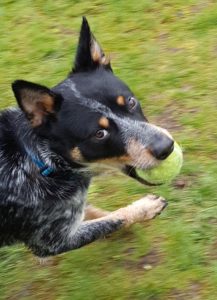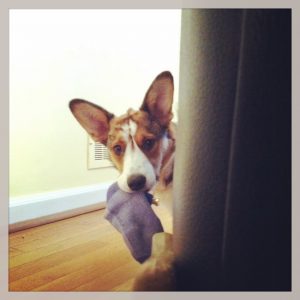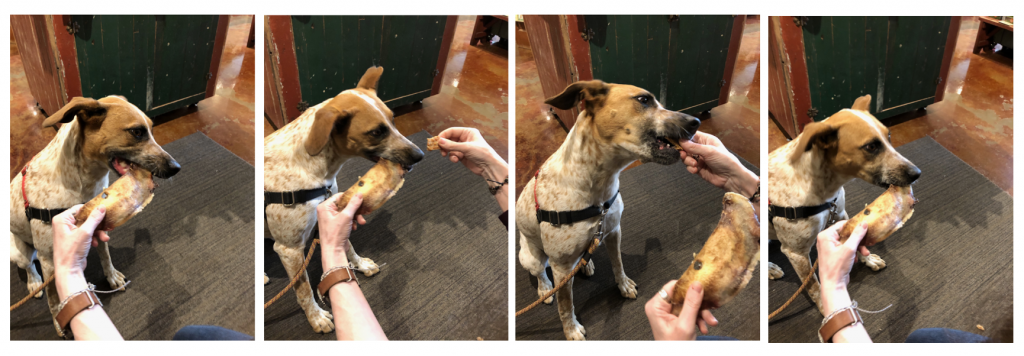Note: this is an article in a recent series of puppy training articles – see the bottom of this page for links!
We know many people during Covid may lack a lot of options when it comes to puppy classes. They do exist in Portland, but these days they are often filled up too quickly, as there are SO MANY new puppies right now. Even if you can find open classes, maybe you don’t feel that comfortable about leaving the house right now. Whatever the reason, I’m hoping to help you along with some specific handy behavior basics. Stay tuned for more!
Drop It!
 A recent customer brought home his 8 week old puppy, and was shocked the second day when he went to take something from her and his tiny little angel growled at him. He came straight into the store very worried that he had adopted a Cujo puppy with a vicious streak. I want to reassure you: protecting resources is a very natural behavior for dogs, and actually for all animals including people. Lions aren’t keen on hyenas stealing their hard-won meal. Think about how much you have to actively teach and remind your toddlers to share – it doesn’t exactly come naturally. Even though our mommas might have taught us well, think about how you might react if a stranger walked by your table in a restaurant and took a handful of your french fries! However, don’t despair, there’s absolutely no reason you can’t teach your new puppy to happily surrender what’s in their possession to their humans!
A recent customer brought home his 8 week old puppy, and was shocked the second day when he went to take something from her and his tiny little angel growled at him. He came straight into the store very worried that he had adopted a Cujo puppy with a vicious streak. I want to reassure you: protecting resources is a very natural behavior for dogs, and actually for all animals including people. Lions aren’t keen on hyenas stealing their hard-won meal. Think about how much you have to actively teach and remind your toddlers to share – it doesn’t exactly come naturally. Even though our mommas might have taught us well, think about how you might react if a stranger walked by your table in a restaurant and took a handful of your french fries! However, don’t despair, there’s absolutely no reason you can’t teach your new puppy to happily surrender what’s in their possession to their humans!
First I’d like you to consider what normally happens: The puppy (who naturally puts absolutely everything in her mouth that she encounters) chews on something like your shoe. You gasp and run over, yank the shoe away and leave her with nothing. Then she’s chewing on an absolutely delicious bully stick but you notice it’s getting floppy and short enough to swallow, so you approach her hastily and take it away. Hmmm. Not so fun. Maybe next time she finds a sock and as you rush over to take it away from her, she runs away with it. She’s starting to understand that if she has something and you rush over saying “no”, you’re going to take it away for sure, and maybe she doesn’t want to lose that fun thing. As she runs away with it, you chase her around (perhaps pretty fun, actually) and when you get the sock in your hand she tugs against it (really fun!) And then she loses it. (Boo. Game over. No fun at all.)
You are in fact actively teaching her not to let you get something she wants to keep, or perhaps that if she’s bored, grabbing something that elicits a chase and tug game is a pretty great idea. If you’re ripping away her most delicious chew, she’s very much NOT going to be motivated to give that up next time, and may even start to get defensive about you “stealing” it away from her. She’s no dummy. She can see patterns in your behavior and learn from them, but unfortunately you might be inadvertently teaching her behaviors that might infuriate you.
mouth that she encounters) chews on something like your shoe. You gasp and run over, yank the shoe away and leave her with nothing. Then she’s chewing on an absolutely delicious bully stick but you notice it’s getting floppy and short enough to swallow, so you approach her hastily and take it away. Hmmm. Not so fun. Maybe next time she finds a sock and as you rush over to take it away from her, she runs away with it. She’s starting to understand that if she has something and you rush over saying “no”, you’re going to take it away for sure, and maybe she doesn’t want to lose that fun thing. As she runs away with it, you chase her around (perhaps pretty fun, actually) and when you get the sock in your hand she tugs against it (really fun!) And then she loses it. (Boo. Game over. No fun at all.)
You are in fact actively teaching her not to let you get something she wants to keep, or perhaps that if she’s bored, grabbing something that elicits a chase and tug game is a pretty great idea. If you’re ripping away her most delicious chew, she’s very much NOT going to be motivated to give that up next time, and may even start to get defensive about you “stealing” it away from her. She’s no dummy. She can see patterns in your behavior and learn from them, but unfortunately you might be inadvertently teaching her behaviors that might infuriate you.
Here’s the recipe for success:
Instead of teaching her that “drop it” means she always loses things she likes, make it a neat opportunity for a reward. The strategy is to start frequently removing easy things that she ultimately doesn’t lose. You’ll just be borrowing them for a moment and giving them back. You’ll want to do many of these tiny exercises a day.
Tip: During this time you’ll want to manage her environment tightly, keeping things like shoes and socks, etc very well put away.
Step One, choose your command and your reward marker. Your command can be anything that you choose such as, “Can I have it?” “Can I borrow this?” “Drop It”. Your reward marker could be “Yes” or “thank you” or “good”. Whichever words you choose should be something that easily springs to your mouth, and it should stay consistent.
Then for this first exercise, lets say she’s laying on her bed and a ratty stuffed toy that she’s not playing with is laying next to her. (You want to start with low value items in calm situations). Get a yummy treat, calmly approach her and put it right to her nose, asking her, “can you Drop It?” or whatever your command is. (With your other hand, casually take the item from the bed, say “yes!!” Or “thank You” (whatever reward marker you have chosen) and give her the treat while you’re holding the toy. When she finishes the treat, praise her and give her the toy right back.
Try to find excuses to practice this very easy exercise a lot, as you’re just establishing a pattern. You can also do random exercises where you present her with some toy that’s hers (that’s not that exciting) and ask her if you can have it right back with the command you’ve chosen, showing her a treat if she leaves the toy laying next to her or perhaps putting it right at her nose if the toy’s in her mouth, calmly removing the item you just gave her, rewarding her with that treat, returning the toy and walking away. If she tries to make a tug game with it, just say “Oops”, drop the toy and walk away with your treat. (If you want to play tug in a different circumstance, present the tug and invite her to get it. You don’t want her to try turn other situations into tug games like when you’re folding laundry).
Tip: You want to show her that 99 times out of 100, when you approach calmly and ask her if you can have what she has, she gets a reward and she also gets the thing right back. Starting with easy things first lays down a valuable precedent. This exercise takes all of 30 seconds, so try to sprinkle it in throughout the day.
Step Two: You can start to try this same exercise with a lower value toy that she’s actively enjoying, whether it’s in her mouth at the moment or not. Work it in a lot of times a day.
Step Three: When she has something of medium value in her mouth, get two really good treats, calmly approach her and press one treat right up against her nose, while you’re calmly reaching for the toy that’s in her mouth with your other hand, asking her with your command to give it up. When she drops it to get the treat, say your reward marker, give the treat to her, and then give her the second treat, praise her, and give her her toy right back into her mouth and walk away. Practicing this a lot with low and medium value toys will likely start to turn your dog into someone that when she has a toy in her mouth and you approach, she’s going to spit it out in anticipation of a treat. If she does release it before you’ve even asked, praise her heartily, ask her with your regular command if you can have it and go through the regular motions, treating and returning her toy to her. You’re almost there!
Step Four: Next, you’re going to present her with something really exciting and ask for it back for just a moment. Get a higher value chew like a bully stick (something that’s easy for you to hang on to for a minute and that you plan to let her have at the end). Be ready with a high value treat. Present her with the bully stick and invite her to “Take It”, but continue to hold it while she chews it a little. Then put your high value treat right up to her nose and ask with your command for the drop it. Ideally she’ll release it to get her treat, and you should also praise her well and give her the bully stick right back, leaving her alone to chew it. You’re showing her that it’s safe to give up even a really good thing for a moment. For a little while, this is how you might present all things to her that she loves – hand it to her, ask her for a quick drop it for a treat and then give it back to her and leave her with it. You’re really showing her that it’s safe to let someone take things, even good things, and that it doesn’t mean she’ll undoubtedly lose it forever. 
Step Five: Taking away a high value item that she’s been working on for a while: This exercise gets harder when they’re really “dug in” to a high value chew. Before you ever progress to step Five, you should feel confident about her being happy with the steps so far (especially step 4) and they have become easy. You’ll want to escalate to a crazy good treat that she never gets (a real piece of meat, or biggish cube of cheese, a piece of deli ham, or whatever would blow her mind) to reward her with for the first time you try, and do return the chew to her right away and leave her be. Getting her solid on this exercise will help you with real life situations.
Real Life : Sometimes she’ll get an object that you have to take away. Hopefully you’ve used management to prevent these incidents with household items, but life happens, like the stringy floppy thing she might choke on, or whatever she’s found in the world that might be dangerous to her if she ate it. Do NOT get worked up and run towards her to take it. Remember that you’ve created a great precedent of calmly approaching her and removing something, so keep a cool head and recreate this exercise. Keep a Tupperware container handy in common areas containing really good special treats and something delicious to trade for the item that you can leave her with handy in common areas for just such an occasion (it’s an excellent bully stick opportunity). Remember: don’t make a fuss, no matter whether she’s decimating something you love (just whack your own nose with a rolled up newspaper for letting her have access to that valued item). Just calmly approach, put the good treat right up her nose (Of course I’m not suggesting you put anything actually up her nose, but by pressing it a bit against her nose, sometimes it distracts her from the fact that she’s letting something go to be able to take that treat), ask for and take the item as you praise her and instead of returning the item to her, this one time out of a hundred she’s going to get something else instead. Give her that bully stick and I doubt she’ll be too affected by the loss.
Tip: Remember, 99 times out of 100 when you approach and ask her to drop it, she gets a reward and gets the thing right back. Why wouldn’t she want you to borrow things from her? It’s a cool deal. If you’re doing these exercises several or more times a day, she’s going to feel incredibly secure about you taking stuff from her.
Tip: Remember, that one time out of a hundred where she has something she shouldn’t have is a valuable moment that shouldn’t be squandered. Be prepared for it, be calm and reward it well, and trade the item for something else (hopefully something good).
Tip: Be practicing this outdoors too. On a walk, bring your treats and one good trade just in case. if she picks up a stick, calmly ask if you can have it, with a treat at her nose, give her the treat and return the stick right back to her to carry. Or if she loves to fetch it, throw it for her after the drop it. This is a good way to phase out the lure (the treat at the nose thing), as the start of a game is great reinforcement for a good drop it. If it’s something she shouldn’t have and is exciting (ie: dead squirrel) make sure your good treat and good trade is handy. Getting her to be good about drop it can be a lifesaver for her in the future if she gets something dangerous. Rewarding it well is a good way to solidify the behavior. Eventually of course she’ll be so secure with the drop it that you won’t always need the lure or the reward, though it’s always a good idea to randomly reinforce behaviors you like to keep them strong.
Note: Resource guarding between dogs is a bit more tricky. If you have multiple dogs, management is important. Perhaps separating the dogs is a good idea when there are valuable items they might squabble over (raw bones, etc). Make their crates a great spot to get high value chews. Practice rewarding the crabby dog for leniency when it comes to the puppy. If they’re both sitting in front of you for treats, give crabby dog the first one, then give the puppy a quick treat and immediately give crabby dog two treats, one at a time. If crabby dog gets paid for allowing puppy to get treats, you’re helping crabby dog to develop more patience and impulse control when it comes to the puppy getting things. If crabby dog blows it, he should be calmly but efficiently removed from the opportunity. “Too bad!”. You don’t want to be unfair to crabby dog for the way he feels, so separation before high value food stuffed toys or bones are presented might be kinder in these situations, so he isn’t made anxious about losing his stuff.
You Can Do It!

Tips for New Puppy Owners
Congratulations on your new puppy! What a fun time you’ll have! We very much want your new baby to live a long, healthy, happy life, so we thought we’d compile some of the nitty-gritty dos-and-don’ts of puppy care. Socialization, nutrition, our favorite chews, tips on potty training, etc!
Raising a Puppy (Or Any New Dog) During Covid19
All of us feel frightened and unsure of how long we’ll be living in this strange, suspended, frightening reality. A new dog is not just a delightful distraction from boredom- that little soul can really be a life raft for your psyche. But, this new-puppy-during-quarantine situation does come with a few unique challenges. How to work on socialization and help to prevent separation anxiety once you go back to work.
What Do They Want? How Should They Get It? (Foundational Thinking For Creating Good Behavior in puppies and kittens! Part One) Often we hapless humans try our best to tell our puppies (and kittens) what we want them to do or especially not do, yet the bad behaviors increase and we struggle to get them to be what we wish they would be, especially when it comes to attention-getting behaviors. I’m here to offer a few rules of thumb for most any behavior you don’t like.
To Treat Or Not To Treat? Foundational Thinking For Creating Good Behavior In Dogs Part 2 : Choose Your Methods of Training Carefully, especially with Reactive/Fearful Dogs.
This is the second article in the series that I call “foundational thinking”, as once you understand how dogs think and learn, and the concepts behind why you use certain methods, you can train just about any behavior you like! I think this article contains what I believe to be some of the most important information I can give you about why we use positive reinforcement, and the dangers of using dominance theory and aversive methods especially when dealing with situations that are uncomfortable for dogs.
Do I Always Have To Use Treats? (Foundational Thinking For Creating Good Behavior In Dogs Part Three) A lot of people worry about training with treats.
* Do I have to keep giving them treats for everything for the rest of their lives?
* Aren’t I bribing them?
* I want them to do things because they want to please me.
* I want them to do things right away and I don’t want to have to show them a treat to get them to listen.
These are all good questions. Here’s how to help your dog be able to do what you ask of them the first time you ask, while continuing to build a good relationship.
Drop It!
We’re continuing our puppy series with discussions of common training challenges. It’s so easy to accidentally create a dog that runs away from you when they get a hold of something they shouldn’t have. Wouldn’t you rather they spit something out of their mouth when you approach? You can do it!
Come!
The “Come!” command is one of the very most important things we can teach our dog. A reliable recall is imperative to get them quickly to safety, to recover them if they happen to get out the door, and to proactively remove them from a situation at the dog park that might evolve into trouble. It’s also a wonderful luxury when you are in a safe quiet place to be able to have your dog off leash and know you can get him right back when you want to. Like the command “Drop It!”, it’s easy to accidentally make mistakes when training this behavior that can undermine your success. Here’s how to succeed in training a reliable recall.

